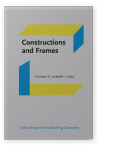Vol. 16:1 (2024) ► pp.30–63
Vertical and horizontal links in constructional networks
Two sides of the same coin?
Recent models of constructional networks combine vertical links between schemas and their subtypes with horizontal links between constructions at the same level of abstraction. It remains unclear, however, whether vertical and horizontal analyses express distinct information about the network, or whether one can be reformulated in terms of the other. In this paper, it is argued that vertical and horizontal links do not encode distinct cognitive mechanisms but that they are notational variants for representing a common notion of constructional similarity. The practical advantages of each notation are outlined, and some potential objections to the present account are addressed.
Article outline
- 1.Introduction
- 2.A blurred distinction: Previous accounts of vertical and horizontal links
- 2.1Vertical (inheritance) links
- 2.2The allostructions model
- 2.3The paradigmatic model
- 3.The proposal: Vertical and horizontal links as notational variants
- 3.1Similarity as a common conceptual ground
- 3.2Notational variants
- 3.3Advantages of each notation
- 3.4The nature of schemas
- 4.Some possible objections (and replies)
- 4.1What about horizontal syntagmatic relations?
- 4.2Aren’t some things only encoded at the level of the schema?
- 4.3Do (some) horizontal links express contrast rather than similarity?
- 4.4Is it only strong horizontal links that can give rise to a schema?
- 5.Conclusion
- Acknowledgements
- Notes
-
References
